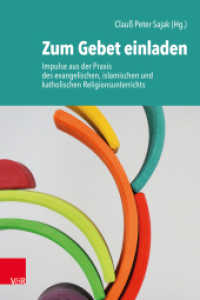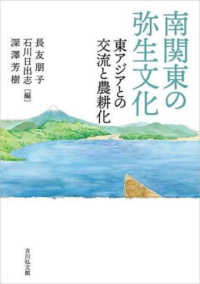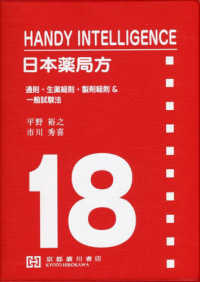- ホーム
- > 洋書
- > 英文書
- > Science / Mathematics
基本説明
This pioneering study traces a rich history over an impressive span of time, from Saint Basil's Hexameron of the fourth century to the globalization of scientific debates in the twentieth century.
Full Description
People have pondered conflicts between science and religion since at least the time of Christ. The millennia-long debate is well documented in the literature in the history and philosophy of science and religion in Western civilization. Science and Eastern Orthodoxy is a departure from that vast body of work, providing the first general overview of the relationship between science and Christian Orthodoxy, the official church of the Oriental Roman Empire. This pioneering study traces a rich history over an impressive span of time, from Saint Basil's Hexameron of the fourth century to the globalization of scientific debates in the twentieth century. Efthymios Nicolaidis argues that conflicts between science and Greek Orthodoxy-when they existed-were not science versus Christianity, but rather ecclesiastical debates that traversed the whole of society. Nicolaidis explains that during the Byzantine period, the Greek fathers of the church and their Byzantine followers wrestled passionately with how to reconcile their religious beliefs with the pagan science of their ancient ancestors. What, they repeatedly asked, should be the church's official attitude toward secular knowledge?
From the rise of the Ottoman Empire in the fifteenth century to its dismantlement in the nineteenth century, the patriarchate of Constantinople attempted to control the scientific education of its Christian subjects, an effort complicated by the introduction of European science in the seventeenth and eighteenth centuries. Science and Eastern Orthodoxy provides a wealth of new information concerning Orthodoxy and secular knowledge-and the reactions of the Orthodox Church to modern sciences.
Contents
Introduction
Chronology
1. The Activist and the Philosopher: The Hexaemerons of Basil and of Gregory of Nyssa
2. Two Conceptions of the World: The Schools of Antioch and Alexandria
3. No Icons, No Science: The End of a Tradition?
4. The Return for Greek Science: The First Byzantine Humanism
5. Struggle for Heritage: Science in Nicaea and the Byzantine Renaissance
6. Political Debates Become Scientific: The Era of the Palaiologos
7. True Knowledge and Ephemeral Knowledge: The Hesychast Debate
8. Ancients versus Moderns: Byzantium and Persian, Latin, and Jewish Sciences
9. The Fall of the Empire and the Exodus to Italy
10. A Rebel Patriarch: Cyril Lucaris and Orthodox Humanism inScience
11. Toward Russia: The Slavo-Greco-Latin Academy and the Patriarchate of Jerusalem
12. Who Were the Heirs of the Hellenes? Science and the Greek Enlightenment
13. The Scientifi c Modernization of an Orthodox State: Greece from Independence to the European Union
14. Science and Religion in the Greek State: Materialism and Darwinism
Conclusion
A Note on Secondary Sources
Notes
Selected Bibliography
Index








